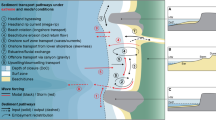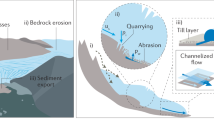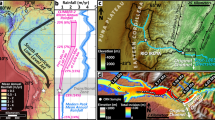Abstract
The erosion of mountain belts controls their topographic and structural evolution1,2,3 and is the main source of sediment delivered to the oceans4. Mountain erosion rates have been estimated from current relief and precipitation, but a more complete evaluation of the controls on erosion rates requires detailed measurements across a range of timescales. Here we report erosion rates in the Taiwan mountains estimated from modern river sediment loads, Holocene river incision and thermochronometry on a million-year scale. Estimated erosion rates within the actively deforming mountains are high (3–6 mm yr-1) on all timescales, but the pattern of erosion has changed over time in response to the migration of localized tectonic deformation. Modern, decadal-scale erosion rates correlate with historical seismicity and storm-driven runoff variability. The highest erosion rates are found where rapid deformation, high storm frequency and weak substrates coincide, despite low topographic relief.
This is a preview of subscription content, access via your institution
Access options
Subscribe to this journal
Receive 51 print issues and online access
$199.00 per year
only $3.90 per issue
Buy this article
- Purchase on Springer Link
- Instant access to full article PDF
Prices may be subject to local taxes which are calculated during checkout




Similar content being viewed by others
References
Koons, P. O. The topographic evolution of collisional mountain belts: A numerical look at the Southern Alps, New Zealand. Am. J. Sci. 289, 1041–1069 (1989)
Beaumont, C., Fullsack, P. & Hamilton, J. in Thrust Tectonics (ed. McClay, K. R.) 1–18 (Chapman and Hall, London, 1992)
Willett, S. D. Orogeny and orography: the effects of erosion on the structure of mountain belts. J. Geophys. Res. 104, 28957–28981 (1999)
Milliman, J. D. & Syvitsky, J. P. M. Geomorphic/tectonic control of sediment discharge to the ocean: The importance of small mountainous rivers. J. Geol. 100, 525–544 (1992)
Teng, L. S. Geotectonic evolution of late Cenozoic arc-continent collision in Taiwan. Tectonophysics 183, 57–76 (1990)
Liew, P. M. et al. Holocene tectonic uplift deduced from elevated shorelines, eastern Coast Range of Taiwan. Tectonophysics 222, 55–68 (1993)
Liu, T. K. Tectonic implications of fission-track ages from the Central Range, Taiwan. Proc. Geol. Soc. China 25, 22–37 (1982)
Shieh, S. L. et al. Users' Guide for Typhoon Forecasting in the Taiwan Area (VIII) (Central Weather Bureau, Taipei, 2000)
Hovius, N., Stark, C. P., Chu, H. T. & Lin, J. C. Supply and removal of sediment in a landslide-dominated mountain belt: Central Range, Taiwan. J. Geol. 108, 73–89 (2000)
Hartshorn, K., Hovius, N., Dade, W. B. & Slingerland, R. L. Climate-driven bedrock incision in an active mountain belt. Science 297, 2036–2038 (2002)
Water Resources Agency. Hydrological Yearbook of Taiwan, Republic of China (Ministry of Economic Affairs, Taipei, 1970–2001); at 〈http://gweb.wra.gov.tw/wrweb/〉.
Li, Y. H. Denudation of Taiwan island since the Pleistocene epoch. Geology 4, 105–107 (1976)
Fuller, C. W., Willett, S. D., Hovius, N. & Slingerland, R. Erosion rates for Taiwan mountain basins: New determinations from suspended sediment records and a stochastic model of their temporal variation. J. Geol. 111, 71–87 (2003)
Hsieh, M. L. & Knuepfer, P. L. K. Middle-late Holocene river terraces in Erjen River basin, south-western Taiwan—implications of river response to climate change and active tectonic uplift. Geomorphology 38, 337–372 (2001)
Willett, S. D., Fisher, D., Fuller, C., Yeh, E. C. & Lu, C. Y. Erosion rates and orogenic wedge kinematics in Taiwan inferred from apatite fission track thermochronometry. Geology 31, 945–948 (2003)
Hickman, J. B., Wiltschko, D. V., Hung, J. H., Fang, P. & Bock, Y. in Geology and Geophysics of an Arc-Continent Collision, Taiwan (eds Byrne, T. B. & Liu, C. S.) 75–92 (Geological Society of America Special Paper 358, GSA, Boulder, CO, 2002)
Hsieh, M. L. & Knuepfer, P. L. K. in Geology and Geophysics of an Arc-Continent Collision, Taiwan (eds Byrne, T. B. & Liu, C. S.) 55–74 (Geological Society of America Special Paper 358, GSA, Boulder, CO, 2002)
Liew, P. M., Kuo, C. M., Huang, S. Y. & Tseng, M. H. Vegetation change and terrestrial carbon storage in eastern Asia during the Last Glacial Maximum as indicated by a new pollen record from central Taiwan. Glob. Planet. Change 16–17, 85–94 (1998)
Keefer, D. K. Landslides caused by earthquakes. Geol. Soc. Am. Bull. 95, 406–421 (1984)
Yu, S. B., Chen, H. Y. & Kuo, L. C. Velocity field of GPS stations in the Taiwan area. Tectonophysics 274, 41–59 (1997)
Montgomery, D. R., Balco, G. & Willett, S. D. Climate, tectonics, and the morphology of the Andes. Geology 27, 579–582 (2001)
Finlayson, D. P., Montgomery, D. R. & Hallet, B. Spatial coincidence of rapid inferred erosion with young metamorphic massifs in the Himalayas. Geology 30, 219–222 (2002)
Kao, S. J. & Liu, K. K. Estimating the suspended sediment load by using the historical hydrometric record from the Lanyang-Hsi watershed. Terrestr. Atmos. Oceanic Sci. 12, 401–414 (2001)
Cohn, T. A. Recent advances in statistical methods for the estimation of sediment and nutrient transport in rivers. Rev. Geophys. 33(suppl.) 1–18 (1995)
Stuiver, M. & Raimer, P. J. Extended 14C data base and revised CALIB 3.0 14C age calibration program. Radiocarbon 35, 215–230 (1993)
Bagnold, R. A. The flow of cohesionless grains in fluids. Phil. Trans. R. Soc. Lond. A 249, 335–397 (1956)
Whipple, K. X. & Tucker, G. E. Dynamics of the stream-power river incision model: Implications for height limits of mountain ranges, landscape response timescales, and research needs. J. Geophys. Res. 104, 17661–17674 (1999)
Ho, C. S. An Introduction to the Geology of Taiwan: Explanatory Text of the Geological Map of Taiwan 2nd edn (Central Geological Survey, Ministry of Economic Affairs, Taipei, 1986)
Carena, S., Suppe, J. & Kao, H. Active detachment of Taiwan illuminated by small earthquakes and its control of first-order topography. Geology 30, 935–938 (2002)
Ekström, G. & Dziewonski, A. M. Evidence of bias in the estimation of earthquake size. Nature 332, 319–323 (1988)
Acknowledgements
This work was supported by the UK Natural Environment Research Council with a CASE addition from Faber Maunsell plc, and by the Taiwan National Science Council, and the Royal Society. We thank P. Molnar and D. Burbank for constructive reviews, and N. Lang and S. Pegg for assistance with data analysis.
Author information
Authors and Affiliations
Corresponding author
Ethics declarations
Competing interests
The authors declare that they have no competing financial interests.
Supplementary information
Rights and permissions
About this article
Cite this article
Dadson, S., Hovius, N., Chen, H. et al. Links between erosion, runoff variability and seismicity in the Taiwan orogen. Nature 426, 648–651 (2003). https://doi.org/10.1038/nature02150
Received:
Accepted:
Issue Date:
DOI: https://doi.org/10.1038/nature02150
This article is cited by
-
An insight into the microphysical attributes of northwest Pacific tropical cyclones
Scientific Reports (2023)
-
Yam Seep at Four-Way Closure Ridge: a prominent active gas seep system at the accretionary wedge SW offshore Taiwan
International Journal of Earth Sciences (2023)
-
The principle, application, and prospect of using the uranium comminution age to indicate the catchment erosion depth
Science China Earth Sciences (2023)
-
Surface deformation induced by the 2016 Meinong earthquake and its implications to active folds
Terrestrial, Atmospheric and Oceanic Sciences (2023)
-
Topography of mountain belts controlled by rheology and surface processes
Nature (2022)
Comments
By submitting a comment you agree to abide by our Terms and Community Guidelines. If you find something abusive or that does not comply with our terms or guidelines please flag it as inappropriate.



